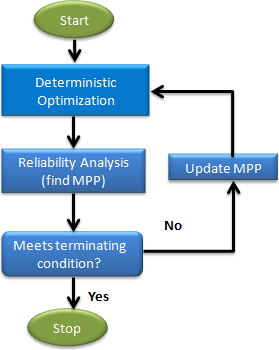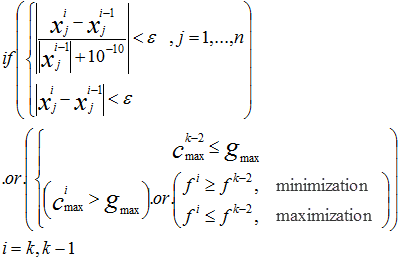Reliability and robustness based optimization methods require many design evaluations, therefore improving their efficiency is one of the issues. SORA-ARSM attempts to address this issue by using Adaptive Response Surface Method (ARSM). In this process, response surfaces are created and an optimization is carried out on the surfaces. During deterministic optimization and reliability analysis, response surfaces are adaptively updated for increased accuracy.
Usability Characteristics
| • | SORA-ARSM is the most efficient of the three RBDO methods available in HyperStudy, but it is also the least accurate. |
| • | An extension of SORA_ARSM is implemented in HyperStudy to allow for robust design optimization. Robust design optimization attempts to minimize the objective variance in order to reduce its sensitivity to design variations and consequently increase the design's robustness. The implementation in HyperStudy is based on the use of percentiles for the objective function and is turned on via the Robust Optimization setting in the Specification step. |
| • | SORA-ARSM terminates if one of the conditions below are met: |
| - | One of the three convergence criteria are met. |
| o | The absolute objective change is less than a convergence tolerance value (SOREPS) and there is no constraint violation (GMAX) in the last design. |
| o | The relative objective change is less than a convergence tolerance value (SOREPS) and there is no constraint violation (GMAX) in the last design. |
| o | The absolute change and relative change of each input variable (SOREPS) is less than a convergence tolerance value. Also, there is no constraint violation (GMAX) in the last design. |
| - | The maximum number of allowable iterations (MAXDES) is reached. |
An exception is when the absolute change and relative change of each input variable is less than this value in the last two consecutive designs or when we have found feasible designs and the best feasible design has not been improved during the last two consecutive iterations. When this occurs, SORA-ARSM will be terminated.
| • | The reliability analysis is carried out by searching for the most probable point (MPP). Issues such as non-uniqueness of the MPP and highly non-linear output response functions can reduce the accuracy of the reliability calculation. |
The flowchart below illustrates the different phases of the SORA_ARSM process.
| Note: | The flowchart for SORA_ARSM is the same as SORA flowchart, except that the deterministic optimization and reliability analysis are done based on response surfaces, which is updated with newly evaluated designs. |
|

Settings
In the Specifications step, you can change the settings of SORA_ARSM from the following tabs:
In the Settings tab, you can access the settings listed below. Please note that for most applications the default settings work optimally, and you may only need to change the Maximum Iterations and Robust Optimization.
Setting
|
Default
|
Range
|
Description
|
Maximum Iterations
(MAXDES)
|
25
|
> 0
|
Maximum number of iterations allowed.
|
Angle convergence tol.
(MPPTOL)
|
0.25
|
>0.0
|
Angle convergence tolerance for inverse MPP search, in unit of degrees. If the angle between the vector of  (design point in standard normal distribution space) and the negative gradient falls within the tolerance, then inverse MPP search is regarded as converged. (design point in standard normal distribution space) and the negative gradient falls within the tolerance, then inverse MPP search is regarded as converged.
A smaller value favors a higher precision of reliability analysis, but more computational effort is needed.
|
Robust Optimization
(ROBUST)
|
Off
|
Off, On
|
To decide whether this is robust optimization or not; 0 means that you do not use robust optimization; 1 means that robust optimization is used.
|
Constraint violation tol.
(GMAX)
|
0.1
|
> 0.0
|
Global maximum allowable percentage constraint violation. Constraints must not be violated by more than this value in the converged design.
|
Robust Min %
(ROBMINPV)
|
95.0
|
>50,
<100
|
Define percentile value of robust optimization for minimization objective.
|
Robust Max %
(ROBMAXPV)
|
5.0
|
>0,
<50
|
Define percentile value of robust optimization for maximization objective.
|
|
In the More tab, you can access the setting listed below. Please note that for most applications, the default settings work optimally.
Setting
|
Default
|
Range
|
Description
|
Termination criteria
(SOREPS)
|
1.0E-4
|
>0.0
|
If the absolute or relative change of the objective value is less than this value, or the absolute or relative change of the input variables is less than this value, and the constraint violation is not larger than this value, then SORA_ARSM will be terminated. Also, there must not be any constraints with an allowable violation that has been exceeded in the last design.
An exception is when the absolute change and relative change of each input variable is less than this value in the last two consecutive designs or when we have found feasible designs and the best feasible design has not been improved during the last two consecutive iterations, SORA_ARSM will be terminated.

Where,  is the input variable; is the input variable;  is the objective; is the objective;  is the number of input variables; is the number of input variables;  is the current iteration number; is the current iteration number;  is the maximum constraint violation; is the maximum constraint violation;  is the allowable constraint violation; is the allowable constraint violation;  is the value of the termination criteria. is the value of the termination criteria.

|
Move limit friction
(MOVE)
|
0.15
|
0.0 < MOVE < 1.0
|
Move limit fraction.
Smaller values allow more steady convergence (smaller fluctuation of the output response values), but more computational effort could be consumed. The value will be adaptively updated during the optimization process.
|
Initial linear move
(MPERT)
|
1
|
1 or 3
|
1
|
By DV initial.
Initial move = PERT * MOVE * abs(INI)
(Default when initial value of input variable is non-zero)
An exception is that initial move will be set to minimum move if it is less than minimum move.
Minimum move = MINMOVE * (UB-LB) if (UB-LB) is less than 1.
Minimum move = MINMOVE if (UB-LB) is not less than 1 and absolute value of INI is less than 1.
Minimum move = MINMOVE * min((UB-LB),abs(INI)) if (UB-LB) is not less than 1 and absolute value of INI is not less than 1.
|
3
|
By DV bounds.
Initial move = PERT * MOVE * (UB-LB)
(Default when initial value of input variable is zero)
|
INI: Initial input variable value.
LB, UB: Lower and upper bounds on input variable.
|
Minimal Move Factor
(MINMOVE)
|
0.1
|
0.0 < MINMOVE < MOVE
|
Minimal move factor.
See the usage of MINMOVE in MPERT.
|
Initial DV perturbation
(PERT)
|
1.1
|
≠ 0.0
|
Initial input variable perturbation value.
Larger values result in a wider spread of the initial  designs ( designs ( is the number of input variables; the is the number of input variables; the  designs together with the start design can determine a linear response surface). ARSM will search the design space more widely. designs together with the start design can determine a linear response surface). ARSM will search the design space more widely.
|
Use SVD
(SVDRSM)
|
False
|
False or True
|
If SVDRSM is 0, ARSM is terminated in case of soft convergence (when the current design is the same or little change (1.0e-15) to one of the history designs).
If SVDRSM is 1, Singular Value Decomposition is activated to build the response surfaces and the optimization process will be continued.
The above can be formulated as:

Where,  is the current iteration number; is the current iteration number;  is the number of input variables; is the number of input variables;  is one of the history designs. is one of the history designs.
|
Revision
|
A
|
A or B
|
This parameter is used to help when there is a convergence difficulty. By default, "A" is selected meaning the legacy algorithm.
|
Constraint threshold
(EPSCON)
|
1.0e-4
|
> 0.0
|
This parameter is used for constraint value calculation. In general, constraint value is normalized to its bound value. One exception is that, constraint value is not normalized if its absolute bound value is less than this parameter. Recommended range is 1.0e-6 ~ 1.0.
|
|












